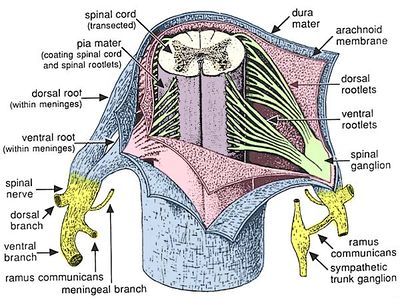Nerves of the Lumbar Spine: Difference between revisions
From WikiMSK
No edit summary |
No edit summary |
||
| Line 11: | Line 11: | ||
==Lumbar Nerve Roots== | ==Lumbar Nerve Roots== | ||
[[File:Spinal meninges.jpg|thumb|right|400px]] | |||
*The dorsal root transmits sensory fibres from the spinal nerve to the spinal cord | *The dorsal root transmits sensory fibres from the spinal nerve to the spinal cord | ||
*The ventral root transmits mostly motor fibres from the spinal cord to the spinal nerve | *The ventral root transmits mostly motor fibres from the spinal cord to the spinal nerve | ||
| Line 21: | Line 22: | ||
*The cerebrospinal fluid (CSF) is within the subarachnoid space | *The cerebrospinal fluid (CSF) is within the subarachnoid space | ||
*The nerve fibres within the nerve roots run in a single trunk for most of their course | *The nerve fibres within the nerve roots run in a single trunk for most of their course | ||
*Near the spinal cord they separate into rootlets which are smaller bundles, and attach to the spinal cord. | |||
*There are between 2-12 rootlets for each root, and are 0.5-1mm in diameter. | |||
==References== | ==References== | ||
Revision as of 19:30, 22 April 2021
The lumbar spinal nerves lie in the intervertebral foraminae, and are connected by spinal nerve roots to the spinal cord. The spinal nerves divide into the ventral and dorsal rami outside the vertebral column. The lumbar sympathetic trunks run along the anterolateral lumbar vertebral column, and they communicate with the ventral rami of the lumbar spinal nerves
Lumbar Spinal Nerves
- The lumbar spinal nerves are numbered according to the vertebra beneath which they lie. The L1 spinal nerve lies below the L1 vertebra in the L1/2 intervertebral foramen. The L2 spinal nerve lies below the L2 vertebra in the L2/3 intervertebral foramen etc.
- Each spinal nerve is connected centrally to the spinal cord by a dorsal and ventral root.
- The joining of the spinal nerve roots to the spinal nerve occurs in the intervertebral foramen.
- The spinal nerve divides peripherally into a larger ventral ramus and smaller dorsal ramus.
- The branching into the two rami occurs outside the foramen.
- The spinal nerves are short, and no longer than the width of their intervertebral foramen.
- They are generally a few millimetres, but can be less than 1mm with the roots branching directly into rami without the formation of a proper spinal nerve.
Lumbar Nerve Roots
- The dorsal root transmits sensory fibres from the spinal nerve to the spinal cord
- The ventral root transmits mostly motor fibres from the spinal cord to the spinal nerve
- The ventral root may also transmit some sensory fibres
- The L1 and L2 ventral roots also transmit preganglionic, sympathetic, efferent fibres
- The spinal cord has its termination opposite the L1/2 intervertebral disc, but the range is T12/L1 to L2/3.
- The lower lumbar and sacral nerve roots run within the vertebral canal largely enclosed in the dural sac.
- In the cauda equina, the lumbar, sacral, and coccygeal nerve roots run freely
- Each root is covered by individual pia mater, continuous with the pia mater of the spinal cord.
- The cerebrospinal fluid (CSF) is within the subarachnoid space
- The nerve fibres within the nerve roots run in a single trunk for most of their course
- Near the spinal cord they separate into rootlets which are smaller bundles, and attach to the spinal cord.
- There are between 2-12 rootlets for each root, and are 0.5-1mm in diameter.
References
These are study notes taken from Chapter 10 of:
- Bogduk, Nikolai. Clinical and radiological anatomy of the lumbar spine. Edinburgh: Elsevier/Churchill Livingstone, 2012.


